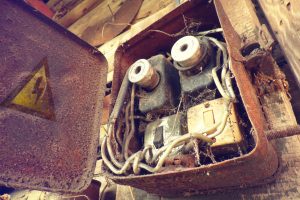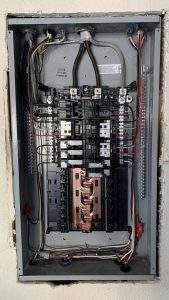
Should I Rewire My Whole House? Signs, Safety Risks, and What You Need to Know
May 3, 2025

If you’re living in an older home or dealing with electrical issues, you may have wondered: Do I need a whole house rewire? The answer depends on several factors, including the age of your wiring, the type of materials used, and recurring problems like tripping breakers or discolored outlets.
If you’re searching for an electrician near you to upgrade your home’s wiring, Dollens Electric is here to help. Our local San Jose electricians are familiar with the wiring challenges in older Bay Area homes.
At Dollens Electric, we often hear homeowners ask, “What should I be looking for that tells me I need a rewire?” So, let us break down the most common warning signs and explain why rewiring might be the safest, smartest solution—along with what you can expect if you decide to proceed.
Knob and Tube Wiring – Why Replace it in Older San Jose Homes?
- Home Inspection or Safety Concerns: Unsafe wiring flagged during a sale or remodel.
- Persistent Circuit Breaker Trips: Breakers trip repeatedly, and the cause isn’t immediately apparent.
- Outdated or Hazardous Wiring Materials: Such as aluminum wiring, cloth Romex, or knob and tube systems.
What's the Problem with Aluminum Wiring?
Aluminum wiring was used in homes—primarily built between 1965 and 1976—as a cost-saving measure. Unfortunately, aluminum is softer and less conductive than copper, and it expands and contracts at a different rate, which causes loose connections over time.
These loose connections can lead to arcing, heat buildup, and fire hazards. Even when arc fault breakers are installed for protection, troubleshooting can be costly and time-consuming.
Many homes with aluminum wiring also have mixed-metal connections, where copper pigtails are wire-nutted to aluminum. This creates a risk of electrolysis, accelerating corrosion and leading to further instability.
Common Arc Fault Breaker Issues on Old Wiring
Arc fault circuit breakers can help detect unsafe electrical arcs, but they often don’t indicate why they tripped. That means a service call might be needed to inspect the entire circuit.
At Dollens Electric, we generally avoid connecting new arc fault breakers to old wiring. If a circuit trips after an upgrade, customers may believe the new breaker is faulty when, in reality, the legacy wiring is the problem. This creates unnecessary warranty disputes and added costs.
Instead, we recommend installing new wiring with its own breaker or outlet-level arc fault protection. This isolates the old from the new and prevents confusion.
What About Old Knob and Tube Wiring or Cloth Wiring?

These are early forms of electrical systems, and while they may still function, they aren’t suited for modern loads:
- Knob and Tube Wiring: Pre-1950s wiring with no grounding, low heat rating, and often damaged insulation. It is not recommend to cover this type of wiring with insulation, due to heat concerns and condition of existing system
- Cloth Romex: Later versions had slightly improved safety but lacked grounding and used fragile insulation.
- Crimped Connections are found in older copper wiring and degrade over time because they don’t flex with temperature changes.
Lighting Circuits Are the Most Vulnerable
Overhead lighting, in particular, suffers from heat exposure. The heat from bulbs travels up to the ceiling junction box, causing flaking and brittle wire insulation. These conditions can create arcs and fires, especially with outdated crimp connections.
Can I Keep My Old Copper Wiring?
In some cases, yes.
- If your older copper wiring is two-wire (no ground). We can run a ground wire and replace crimped connections with modern spring-loaded wire nuts, which adapt better to heat and cold.
- Lighting circuits, however, should be replaced entirely, especially if they use cloth insulation or have degraded over time.
Rewiring vs. a Panel Upgrade: What's the Difference?

Many homeowners think they need a full rewire or new panel because their breakers are tripping, but that’s not always true.
Often, the real issue is circuit overload. For example:
- A 15-amp circuit can safely handle about 1,440 watts.
- A space heater uses 1,500 watts alone—already over the limit.
- In older homes, kitchens were often wired with a single 20-amp circuit. A toaster (1,200W) and a coffee maker (900W) on the same circuit will trip it.
So, the problem might not be faulty wiring—it could be modern appliances using an outdated load design. Circuit redistribution or additional circuits may solve the problem more efficiently than a rewire in these cases.
So, What's the Real Benefit of Rewiring?
The #1 benefit of a whole house rewire is peace of mind backed by a warranty. You eliminate outdated, unsafe wiring systems and start fresh with modern copper wiring, grounded circuits, and code-compliant installations.
You also gain:
- Improved electrical safety
- Better support for high-demand appliances
- Fewer mystery trips from arc fault breakers
- Greater home value and insurability
Ready for a Safer Home? If you’re in San Jose or the surrounding Bay Area and notice these warning signs, it may be time to rewire your house. Contact Dollens Electric, your local San Jose electrician, for a thorough inspection and reliable whole-house rewiring services. Our team is here to help keep your home safe and up to code
Questions? Schedule a professional wiring inspection with Dollens Electric. We'll tell you what's good, what's not, and what needs to change.

10 Electrical Upgrades That Instantly Boost Your Home Value

